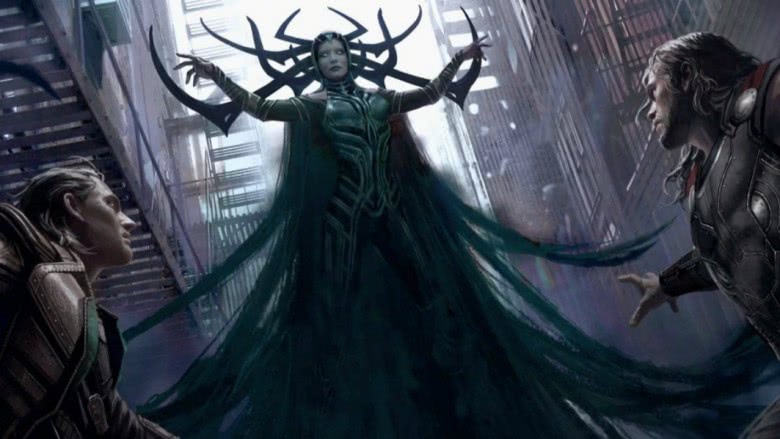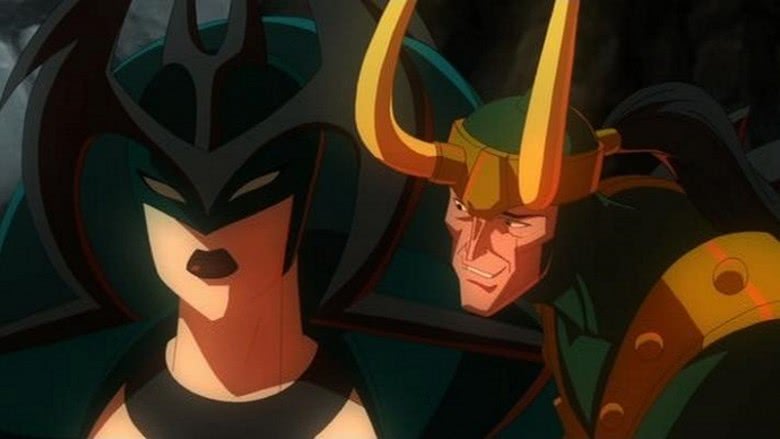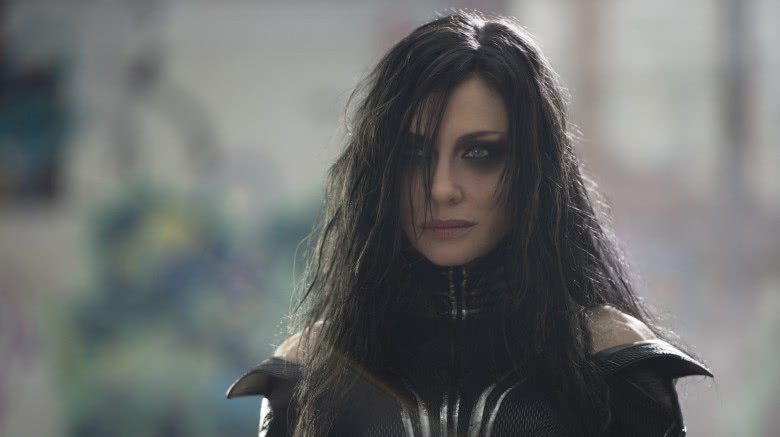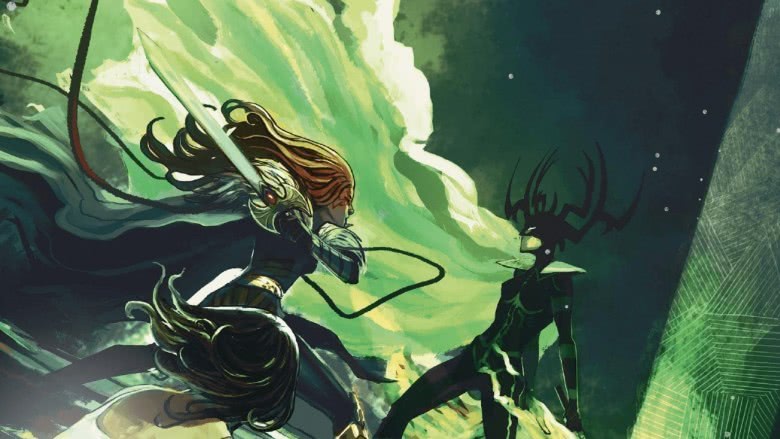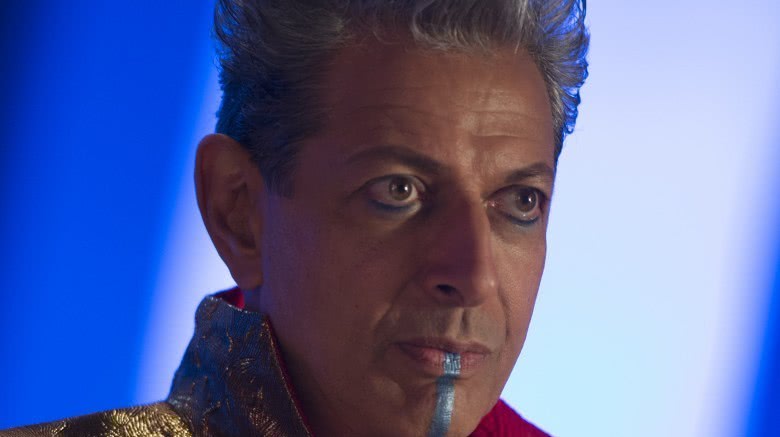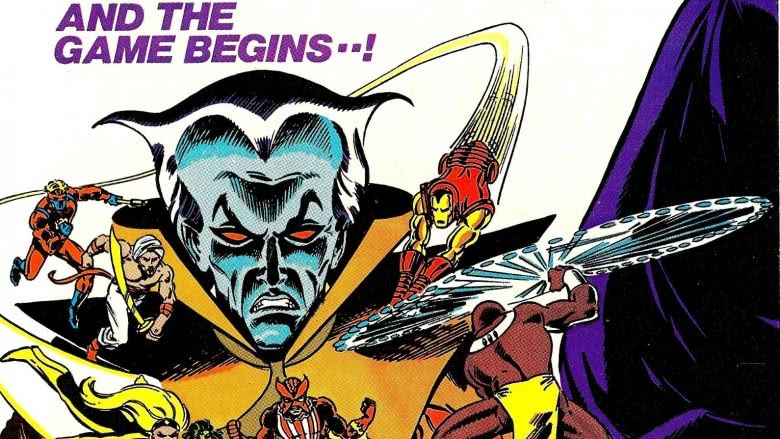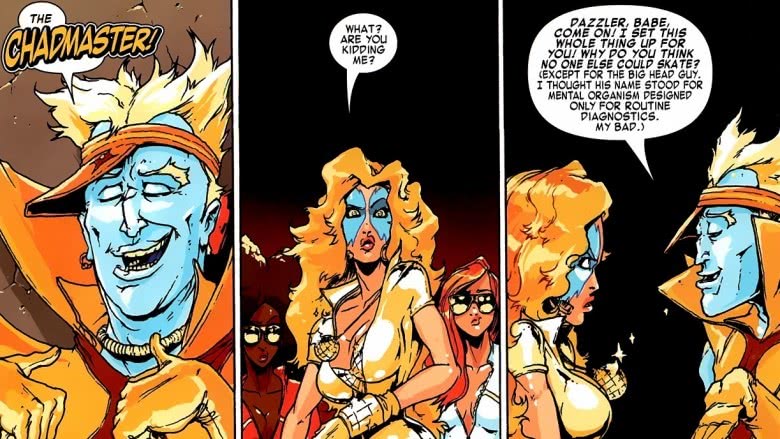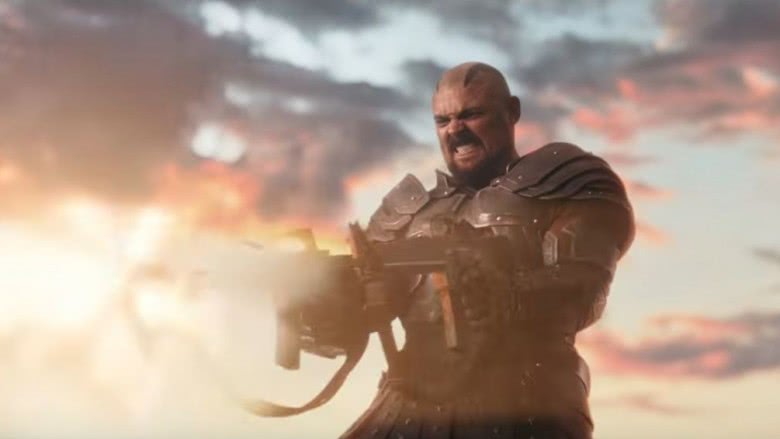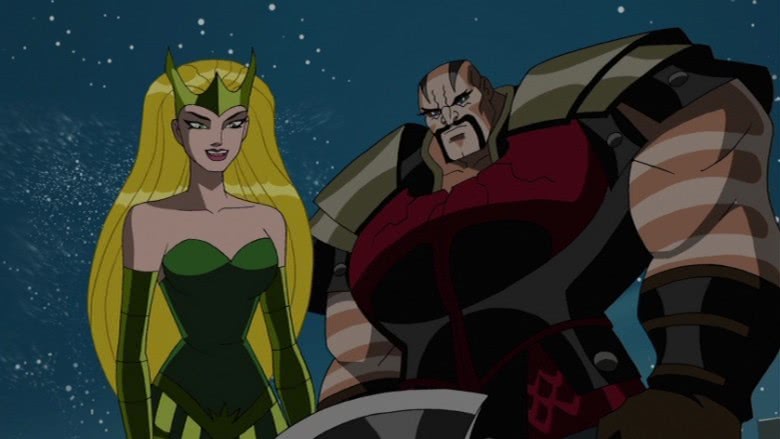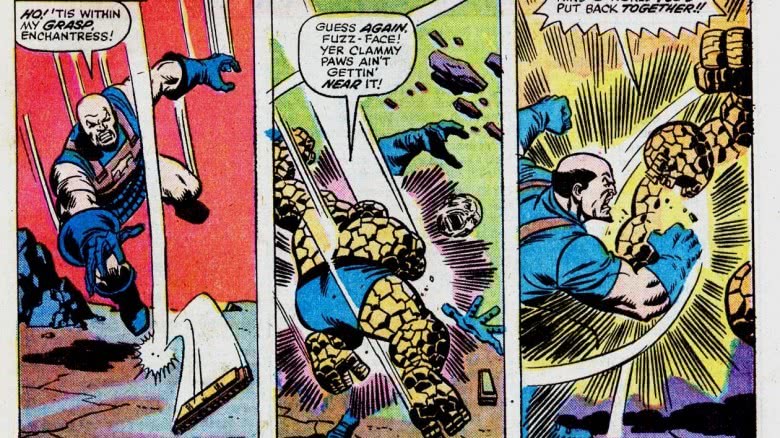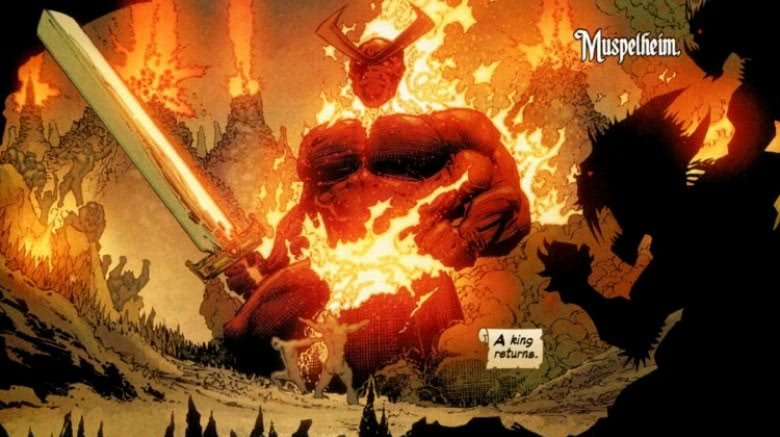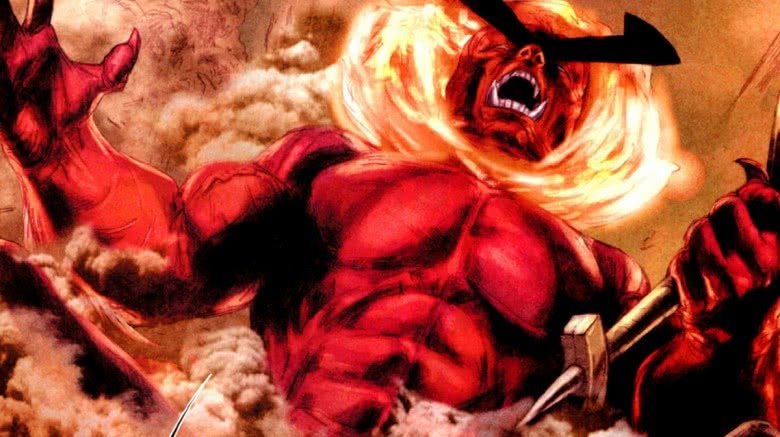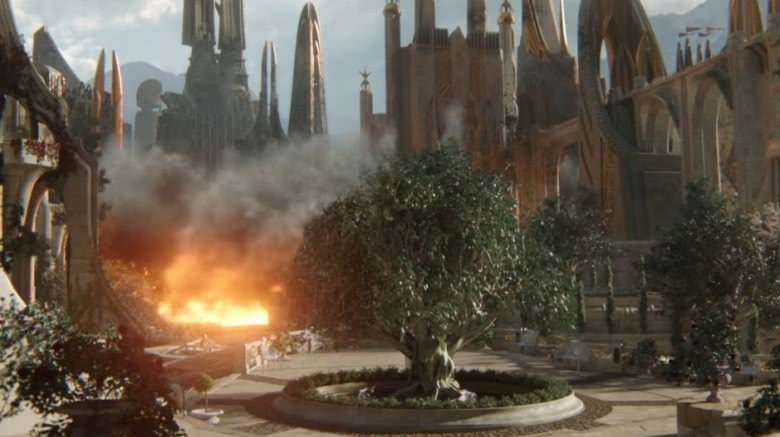What Comic Book Fans Know About Thor: Ragnarok Villains That You Don't
Described as a cross between a road trip movie, a buddy picture, and a cosmic superhero smash-up, Thor: Ragnarok is shaping up to be one of the Marvel Cinematic Universe's most intriguing and epic entries. As the gateway to Marvel's colossal Avengers: Infinity War, it's also introducing a whole host of new foes for displaced Asgardian Thor and his cranky compatriot the Hulk to battle. There's also a lot of comic book history behind these villains that the average moviegoer might not be aware of.
Hela is the daughter of Loki
The Queen of Hel has a slightly muddy origin within the Marvel Universe, thanks to changes to official canon. According to some sources, including the source Norse mythology, Hela is actually the child of everyone's favorite trickster god, Loki Laufeyson. Along with his consort, the giantess sorceress Angrboda, Loki fathered the Midgard Serpent, Fenris the Wolf, and Hela. As a modern woman, she seems to prefer being associated with her kingdom rather than her birthright and doesn't really go by her surname. Of course, if your father was Loki, the god of mischief and lies—albeit a far different variation on the current bane of Thor's existence running around the Marvel Universe—you'd probably keep your last name under wraps too.
Hela also received an alternative origin story during Kieron Gillen's work on the throwback series Journey into Mystery. In this minor retcon, Loki created a girl named Leah, modeled after one of Hela's warriors, to defeat Odin's brother Cul. Later in the story, he sends her back in time to protect her from the wrath of his elder self. (Ah, comics.) At one point, Hela hints that Leah may actually be a young version of herself, which checks out from an anagram standpoint. If so, it would also make Loki and Leah's implied romantic feelings pretty darn creepy.
Whether Cate Blanchett's Hela will rock her classical or modern comic book origins in the Marvel Cinematic Universe is uncertain at this point. Still, those tricksters running the MCU hold a lot of curious cards up their sleeves, so you never know. One thing's for certain, Loki will have something to do with the forthcoming Ragnarok, essentially a cosmic cleansing cycle in Asgardian mythology whereby the Nine Realms are reborn through cataclysm. But whether he sides with his "daughter" or his adopted home is still very much in the air.
Hela rules over the dead in Asgard but not all of them
Upon reaching the appropriate age, Odin gave Hela dominion over all of the spirits of the dead. Of course, Niflheiim and Hel aren't direct Norse mythological correlations to hell or Hades in their Judeo-Christian and Greek counterparts. Hela's dominion is more like Limbo, a place where the dead hang out and aren't particularly angry or ecstatic. Parts of the region are gloomy and miserable (like an all-night diner at 3 a.m.), while other areas are very serene. Even though much of the domain is ruled by Hela, she doesn't hold sway over all the spirits.
Those honored in death find their storied souls carried to Valhalla upon that great cosmic Viking ship and subsequently belong to Odin, something that causes Hela no end of realm-envy. In her quest for greater power and influence, she's even teamed up with other post-life monarchs like Mephesto, Dormammu, and Hades. When the All-Father neglected Valhalla, she made a power grab, although naturally it fell flat. Even though she failed to wrest control of the Asgardian afterlife, at least she got Odin to take better care of the honored dead.
She's currently dethroned in the comics
When it comes to presiding over Hel, few could top the Hand of Glory-using, sword-swinging Hela. She's faced down more than a few would-be conquerors and lived to rule another day—even teaming up with Thor and the Defenders at various points to kick out unwanted intruders. On occasion, she does abdicate her domain to see the universe, but usually it's not by choice, such as her post-Ragnarok existence, running around in Las Vegas for a time. And, in spite of her impressive array of powers and fearsome disposition, she's even been ousted from her realm on occasion.
Most recently, Odin's long-lost daughter Angela came to her realm, seeking her lover, Sera. Imprisoned eternally, the only way the Odinsdottir could bring her back to life was by defeating Hela and becoming Queen of Hel. After a number of trials, she took the throne, although she eventually left her rule to her brother Balder. Outcast from her realm, Hela sought the aid of Thanos to regain her throne and is still somewhat depowered at this point.
Hela's motivation to cause Ragnarok across the MCU is a mystery as of yet. With Thanos hopping around the galaxy searching for Infinity Stones, though, there are more than a few similarities between the third Thor film and the comic books currently running, which is likely far from coincidental.
Grandmaster is one of the oldest beings in the Marvel Universe
As the sole surviving members of their respective species, the Elders of the Universe are all unique. In the case of En Dwi Gast, more commonly known as The Grandmaster, his particular race came into being not long after the Big Bang itself. So yeah, no spring chicken there. Much like his "siblings," such as The Collector, Gast's singular drive maintains his near-endless lifespan, in this case staging elaborate and seemingly pointless games.
Aside from the major biggies like Fulcrum, the Living Tribunal, Chaos, or Death, for example, Grandmaster and his clutch of Elders possess a really long life span. Nowhere near as aged and powerful as the Beyonders or Galactus (who's a survivor from before the Big Bang), Gast far surpasses average superheroes and can throw down with the best of the cosmic gods like Thor. As a result, he takes great joy in pitting Marvel's mightiest heroes against one another for his own amusement.
Jeff Goldblum's portrayal, aside from being an absolute delight, should make Grandmaster's presence in Thor: Ragnarok a devious and enjoyable wildcard. More significantly, he once possessed the Mind Gem, one of the Infinity Stones (called "Gems" at that point), before Thanos swiped it from him. This certainly could be a case of history repeating itself. And since En Dwi Gast doesn't have the best track record for victory—he wouldn't have much to live for if he always won—Thor and Hulk may be in luck, while the entire universe could be in trouble.
Death and the Grandmaster held a Contest of Champions for The Collector's life
Although it's difficult for an Elder of the Universe to pine for the fjords, it does happen. Just such an instance occurred during the lead-in to the very first and now-infamous "Contest of Champions." When Taneleer Tivan's plans backfire, he's disintegrated by powerful cosmic being Korvac. Capable of restoring more simplistic beings to life, Grandmaster is unable to restore the Collector's complex makeup. As a result, he challenges Death herself for Tivan's existence, bringing Marvel's greatest heroes into conflict.
Marvel's first limited crossover event, "Contest" featured two teams of superheroes, including Captain America, Wolverine, Daredevil, She-Hulk, Black Panther, Storm, and many others. They wage war against one another, with neither actually coming out on top. The tie results in Death swapping out the Collector's place in the afterlife for the Grandmaster's own essence. But the battle royale was nothing more than a ploy. Gast manages to steal the cosmic embodiment's powers before tricking her into banishing the Elders from her realm, rendering them eternal in effect.
Rumor has it that Death may stop by Avengers: Infinity War for a visit. Maybe she'll also make a stopover in Thor: Ragnarok on her way to meeting a certain purple, bling-obsessed suitor. Or maybe not.
Grandmaster had a crush on the X-Men's Dazzler
Marvel's Grandmaster may love games above all else, but he's only human—if by human, we mean not remotely human and born long before our ancestors first grunted about social media. A nearly immortal guy who's been zipping around the cosmos for several billion years probably gets lonely, though. Marvel showed the "softer" side of En Dwi Gast during X-Men: To Serve and Protect #4.
The interstellar gamester comes down with a serious case of the hots for mutant pop star Dazzler in this goofy micro-"Contest of Champions." Dropping by Earth, he masquerades as a raver version of himself, the Chadmaster. To impress her, he sets up a one-off life and death roller derby, pitting the X-Woman and her Daughters of the Dragon cohorts Misty Knight and Colleen Wing against a band of supervillains. They manage to defeat the low-grade antagonists and win the deadly derby, and Gast declares their (or her) prize is a date with him. Best of all, Dazzler totally burns Chad, er, Grandmaster, and they beat the crap out of him to boot, leaving him cosmically dejected.
Of course, since Dazzler is a mutant, we'll never see this quirky story in the Marvel Cinematic Universe. Pity.
Skurge isn't necessarily a bad guy
The illegitimate son of a Storm Giant and an Asgardian, Skurge began his comic book life as one of the Nine Realm's most accomplished warriors. Nicknamed the Executioner for his role in defeating the Storm Giants, his first villainous turn came after Amora the Enchantress seduced him and coopted his might for her devious ploys. While Skurge often works against the forces of good—even joining the original Masters of Evil and working alongside Doctor Doom and the Mandarin at one point—he isn't necessarily a villain.
On more than one occasion, the Executioner eschewed his evildoing. At one point, he even sacrificed his beloved Bloodaxe to stop the ship of the dead, preventing one version of Ragnarok. Do we detect some plot points? Skurge also fought alongside Balder and Thor to recover some purloined souls from Hel. During the fray, he sacrificed himself to allow his comrades to escape, dying on the bridge of Gjallerbru while armed only with a pair of M-16s, which also seems eerily familiar. His death assured him a place in Valhalla, at least until the Grandmaster decided to recruit him for his Legion of the Unliving.
This time around, we presume that the MCU's Skurge is a nasty piece of work. Still, Karl Urban's Viking warrior is more complicated than just a hired thug. Of course, with his penchant for being swayed by a pretty (if evil) face, Hela may be the one pulling his strings, heart or otherwise, in Thor: Ragnarok.
Skurge is looking for love in all the wrong places
Typically, Skurge is portrayed as either a villain or an anti-hero in the Marvel Universe. His tough guy demeanor doesn't necessarily predispose him to acts of wickedness, but his heart tends to get played the wrong way an awful lot. From his first appearance in Journey into Mystery #103, the Executioner fell under the spell of Amora the Enchantress, attacking Thor and kidnapping Jane Foster. When he returns Jane from her exile in a parallel dimension, Amora doesn't cotton to his mercy and turns him into a tree.
Most of his misadventures come at the twisted whims of the Enchantress, but Skurge also falls prey to the whiles of another Asgardian sorceress, Casiolena. She convinces him to rule alongside her, stampeding him into battle against the pre-Netflix Defenders–Hulk, Namor, and Doctor Strange, at that point. Let's just say neither their romance nor their conquest pans out.
Despite their long history, Skurge still tries to woo Amora even from the afterlife, asking her to swap places with her fallen sister, Lorelei (not that romantic) so they can be together in Hel (kind of romantic). Not only does the Enchantress rebuke his gesture, she even gives away his beloved Bloodaxe to a mortal. He sure knows how to pick 'em, doesn't he?
Skurge once helped Enchantress obtain the Harmonica of Destiny
In the comic book world, the vast number of sorcerers and sages can, theoretically, imbue just about any object with mystical properties. Typically, these magic items take the form of a powerful weapon like the Ebony Blade, a helpful article of clothing like the Cloak of Levitation, or flashy piece of jewelry like the Orb of Agamotto. Not every enhanced item is quite as wicked cool as an Infinity Gauntlet, though, and the Harmonica of Destiny falls into that category: less impressive on paper but still pretty devastating.
After her death, Celestia Denton was kept alive by the demonic entity the Nameless One. He placed a "spark of life" into her engraved harmonica, giving it the power to fulfill the desires of those who play it. Doctor Strange attained the mystical instrument, spiriting it away to the safety of his Sanctum Sanctorum, before the Enchantress slips on her best Valkyrie disguise and swipes it. She and Skurge run off with it, but it falls into the hands of a disheveled old drunk, who unwittingly busts out a tune to destroy the world—which has to be one sour note. Fortunately, The Thing goes all cosmic Blues Brothers and reverses the fatal song.
Surtur is actually older than the Earth
In the Marvel Universe, age isn't an easy thing to pin down, especially with the continuous "deaths," rebirths, and retcons. Cosmic entities like Galactus span eons in the blink of an eye, so a minor blip like a human being doesn't seem like much to sniff at. While Thanos and other cosmic entities have a mighty long life span, the Asgardians aren't far behind them. For instance, Thor is anywhere between a spry 1,000 and 4,000 years old—although the Marvel Cinematic Universe sets him at about 2,000—which is still pretty fresh next to his old man. Odin, the All-Father, is at least 5,000, if not something more like 10,000 years old.
Surtur, on the other hand, makes them all look like children. A native of the fiery realm of Muspelheim, he towers over Odin both literally and in years. He and his contrasting ice giant foe Ymir are easily on the opposite side of 10,000, with some legends even suggesting they helped in the formation of the Earth. Since his offspring, the Fire Demons, apparently predate the Gods of Asgard themselves, it would stand to reason that Surtur has been around the block a few times. He was also once trapped inside Midgard, which is probably why he bears such a grudge against our quaint blue sphere.
Surtur is more powerful than Odin
Surtur is the god of hellfire, and he sure brings the fire. Easily dwarfing his fellow feisty demons in Muspelheim, Surtur stands at roughly 1,000 feet tall and he's ridiculously strong. He can lift 100 tons, while Odin can only lift about 60 tons. (Odin could lift 90 tons in his prime, but those years are long past.) He's also capable of interdimensional teleportation, as well as telekinesis and pyrokinesis, letting him wield and propel the scorching cosmic energies around him. As if his other potent attributes weren't enough, he also runs around with a wicked blade known as the Twilight Sword, capable of channeling vast amounts of power into it and cutting through dimensions like a knife through lutefisk.
He also happens to be one of Odin's archetypal foes, with a rivalry stretching back eons. In the past, it took the combined forces of Odin, Thor, and their co-Asgardians to bring down the brimstone giant. If Surtur is unleashed during Thor: Ragnarok—whether by Hela, Loki, or some sort of related catastrophe—his presence may explain why Loki and Thor are desperately seeking Odin. And if he's bonded to the mysterious energy source known as the Eternal Flame, Asgard is in even bigger trouble.
Surtur is a part of the Ragnarok cycle of Asgard
Forged during the cataclysmic early days of the universe, the Flame Giant isn't exactly down with being cooped up in Muspelheim. But it's not like you can take a fire demon out for a cup of coffee without some serious repercussions. Despite the best efforts of Thor, Odin, and, when he's feeling less trickster-y, Loki, as well as the other denizens of Asgard, Surtur has still managed to wreak some serious havoc on the Nine Realms.
True, Surtur isn't exactly what you'd call a charmer, but he's also not an enemy of the state of Asgard as much as a force of nature. In both Norse and Marvel mythology, Ragnarok is the primal cleansing of sorts, a cycle of rebirth and renewal. Much of the old world will be burned away, thanks to Surtur primarily, while some aspects survive and others are reborn. Surtur himself represents a key aspect of that cycle. His arrival may have cost the lives of millions, but it also allows the realms to grow and change.
The real question is, if Ragnarok truly dawns in the Marvel Cinematic Universe, who and what will be left of Asgard and its old guard?
